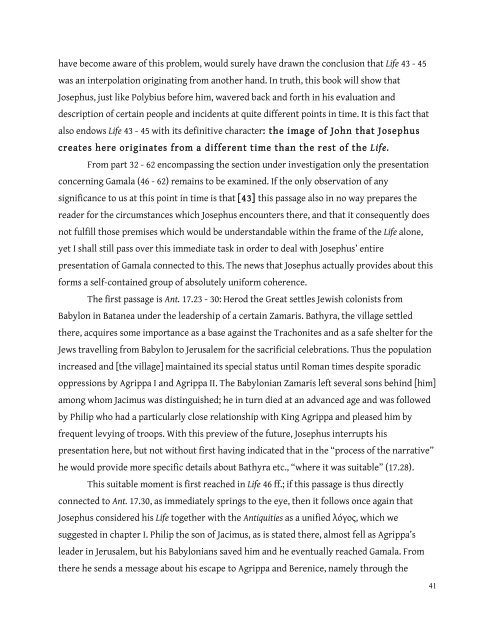The Jewish Historian Flavius Josephus: A Biographical Investigation
The Jewish Historian Flavius Josephus: A Biographical Investigation
The Jewish Historian Flavius Josephus: A Biographical Investigation
Create successful ePaper yourself
Turn your PDF publications into a flip-book with our unique Google optimized e-Paper software.
have become aware of this problem, would surely have drawn the conclusion that Life 43 - 45<br />
was an interpolation originating from another hand. In truth, this book will show that<br />
<strong>Josephus</strong>, just like Polybius before him, wavered back and forth in his evaluation and<br />
description of certain people and incidents at quite different points in time. It is this fact that<br />
also endows Life 43 - 45 with its definitive character: the image of John that <strong>Josephus</strong><br />
creates here originates from a different time than the rest of the Life.<br />
From part 32 - 62 encompassing the section under investigation only the presentation<br />
concerning Gamala (46 - 62) remains to be examined. If the only observation of any<br />
significance to us at this point in time is that [43] this passage also in no way prepares the<br />
reader for the circumstances which <strong>Josephus</strong> encounters there, and that it consequently does<br />
not fulfill those premises which would be understandable within the frame of the Life alone,<br />
yet I shall still pass over this immediate task in order to deal with <strong>Josephus</strong>’ entire<br />
presentation of Gamala connected to this. <strong>The</strong> news that <strong>Josephus</strong> actually provides about this<br />
forms a self-contained group of absolutely uniform coherence.<br />
<strong>The</strong> first passage is Ant. 17.23 - 30: Herod the Great settles <strong>Jewish</strong> colonists from<br />
Babylon in Batanea under the leadership of a certain Zamaris. Bathyra, the village settled<br />
there, acquires some importance as a base against the Trachonites and as a safe shelter for the<br />
Jews travelling from Babylon to Jerusalem for the sacrificial celebrations. Thus the population<br />
increased and [the village] maintained its special status until Roman times despite sporadic<br />
oppressions by Agrippa I and Agrippa II. <strong>The</strong> Babylonian Zamaris left several sons behind [him]<br />
among whom Jacimus was distinguished; he in turn died at an advanced age and was followed<br />
by Philip who had a particularly close relationship with King Agrippa and pleased him by<br />
frequent levying of troops. With this preview of the future, <strong>Josephus</strong> interrupts his<br />
presentation here, but not without first having indicated that in the “process of the narrative”<br />
he would provide more specific details about Bathyra etc., “where it was suitable” (17.28).<br />
This suitable moment is first reached in Life 46 ff.; if this passage is thus directly<br />
connected to Ant. 17.30, as immediately springs to the eye, then it follows once again that<br />
<strong>Josephus</strong> considered his Life together with the Antiquities as a unified λόγος, which we<br />
suggested in chapter I. Philip the son of Jacimus, as is stated there, almost fell as Agrippa’s<br />
leader in Jerusalem, but his Babylonians saved him and he eventually reached Gamala. From<br />
there he sends a message about his escape to Agrippa and Berenice, namely through the<br />
41
















